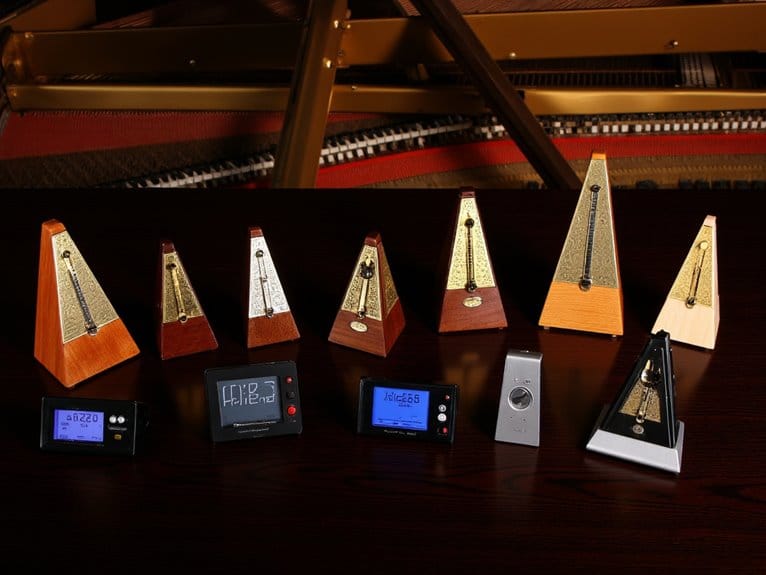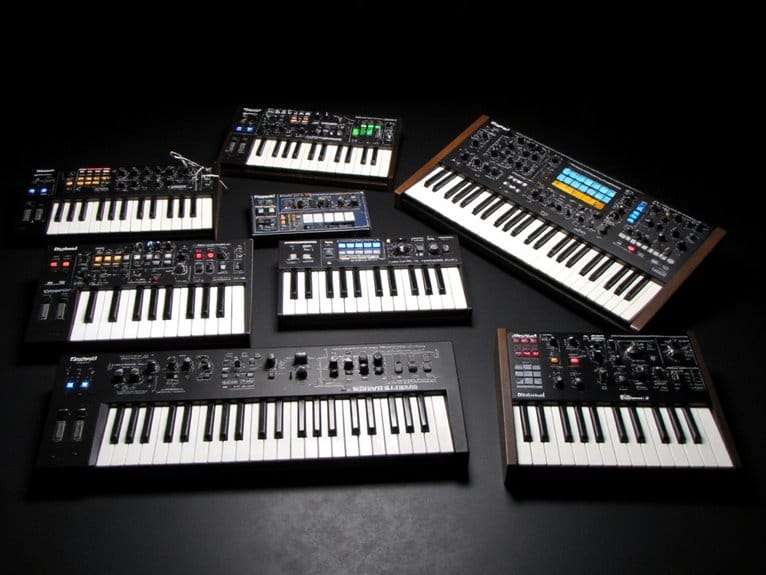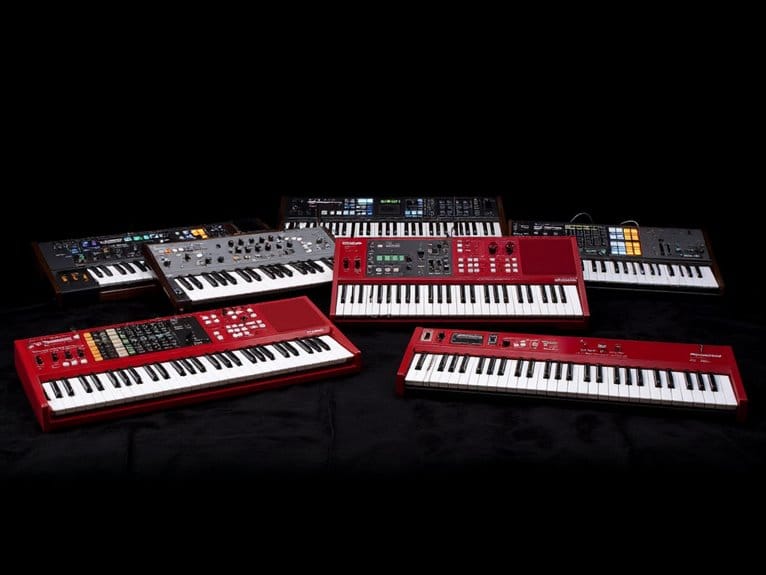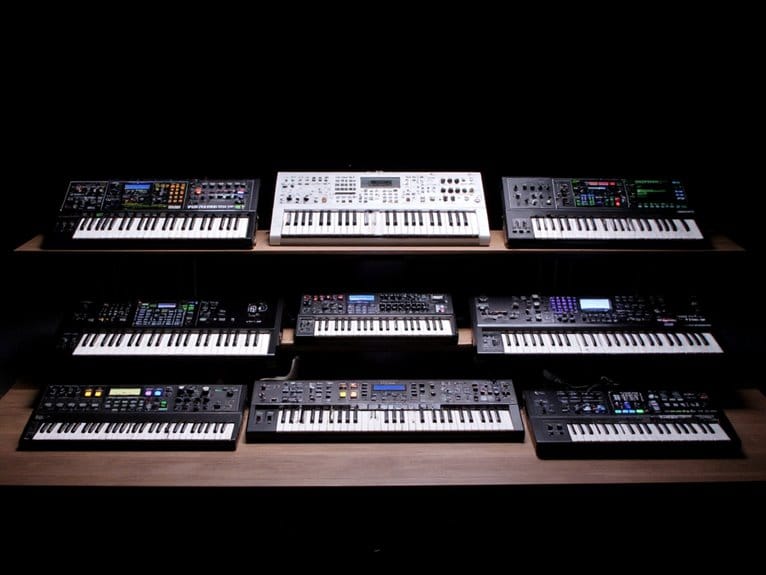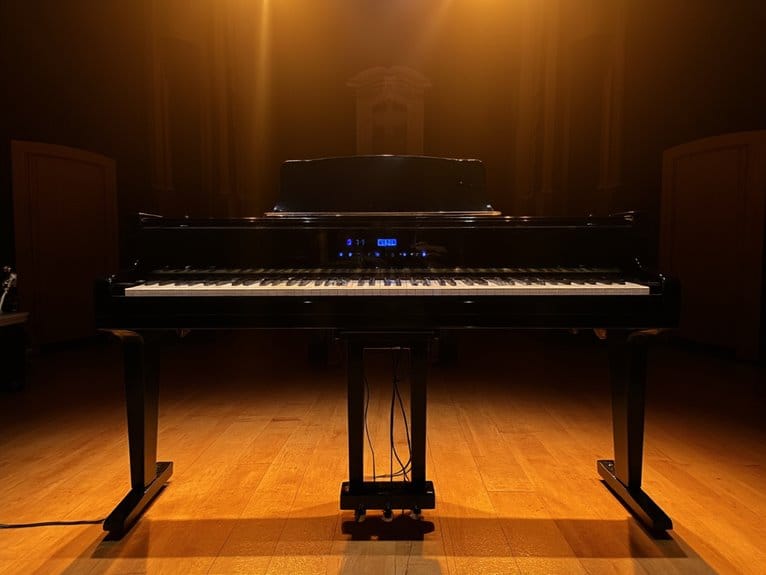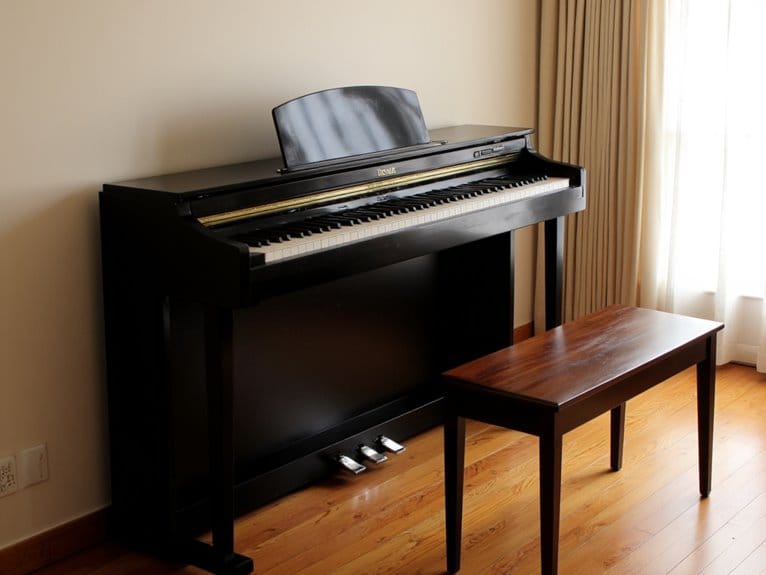10 Best Metronome for Piano
After testing dozens of metronomes for piano practice, I’ve found the AUPHY Mechanical Metronome and Donner Rechargeable 3-in-1 Digital consistently deliver the accuracy pianists need. The AUPHY offers traditional reliability with 1% beat accuracy across 40-208 BPM, while the Donner combines metronome, tuner, and tone generator with visual feedback. Mechanical models like Ueteto provide loud, clear ticking perfect for acoustic pianos, whereas digital options from Sondery and TERENCE offer rechargeable convenience and precise timing. Below, you’ll discover the complete breakdown of each model’s strengths.
We are supported by our audience. When you purchase through links on our site, we may earn an affiliate commission, at no extra cost for you. Learn more.
Notable Insights
- Look for metronomes with 40-208 BPM range and adjustable volume to blend naturally with piano acoustics across different musical styles.
- Mechanical metronomes like AUPHY offer battery-free reliability with 1% beat accuracy, ideal for traditional practice without power concerns.
- Digital models such as Donner 3-in-1 provide precise timing, visual displays, and headphone jacks for silent piano practice sessions.
- Consider metronomes with customizable beat patterns (0-9 beats) and accent bells to practice complex rhythms and time signatures effectively.
- Choose based on portability needs: compact digital models (4.3 oz) for travel versus stable mechanical units (1+ lb) for stationary practice.
Mechanical Metronome with Accent Bell (Wood Grain)
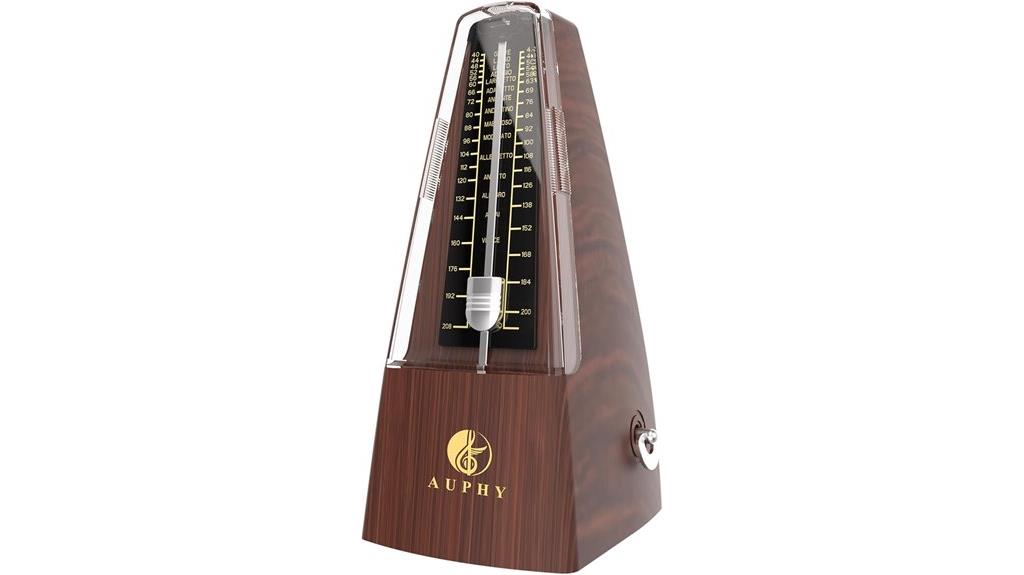
For pianists seeking reliable timing precision without the hassle of battery replacements or digital complications, the AUPHY Mechanical Metronome with Accent Bell emerges as a steadfast companion that bridges traditional craftsmanship with modern reliability. You’ll appreciate its mechanical clockwork mechanism, which delivers beat accuracy within 1% error margin across a 40-208 BPM range, while the accent bell offers five selectable patterns including 2, 3, 4, and 6-beat configurations. The wood grain PC body maintains stability through its lowered center of gravity, and one wind-up provides 10-40 minutes of operation, depending on your chosen tempo, making practice sessions uninterrupted and focused.
Best For: Musicians who prefer traditional mechanical timing devices and want reliable beat accuracy without depending on batteries or digital technology.
Pros:
- High accuracy with beat error controlled within 1% and no battery dependency with wind-up mechanism providing 10-40 minutes of operation
- Versatile accent bell system with 5 selectable beat patterns (2, 3, 4, 6, and off) suitable for various musical styles and instruments
- Stable and durable construction with lowered center of gravity, rust-resistant metal components, and protective dust cover
Cons:
- Requires manual winding every 10-40 minutes depending on tempo, which may interrupt longer practice sessions
- Limited to 40-208 BPM range, which may not accommodate extremely slow or fast musical passages
- Mechanical ticking sound may be distracting in quiet environments or recording situations
Ueteto Mechanical Metronome Black/Loud Sound Piano Drum Violin Guitar
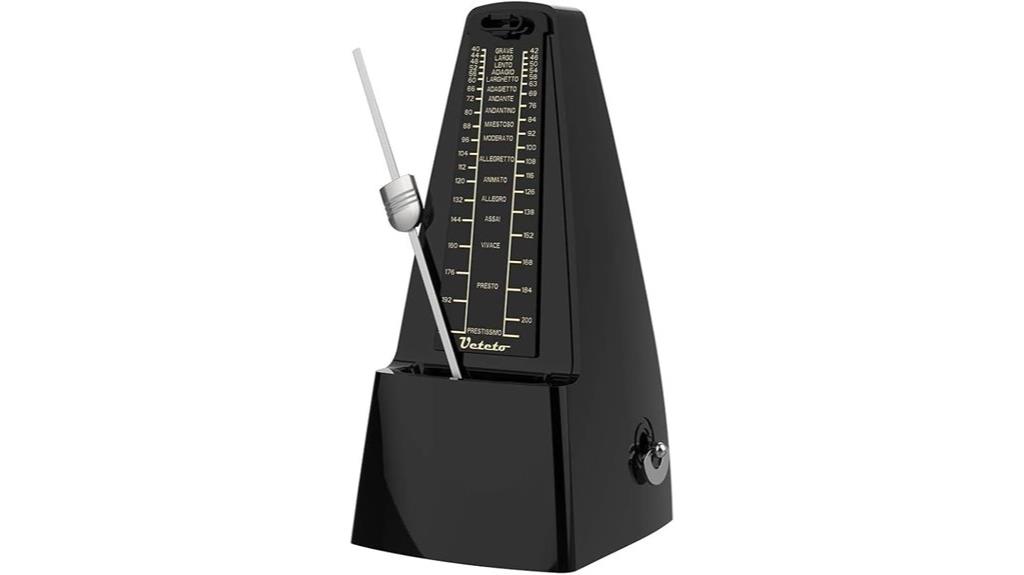
Musicians seeking a traditional metronome that doesn’t rely on batteries or digital displays will find the Ueteto Mechanical Metronome particularly appealing, especially when they need consistent practice sessions without worrying about power sources. This wind-up model delivers a robust tempo range from 40-208 bpm, accommodating everything from slow ballads to rapid technical exercises across piano, violin, guitar, and drum applications. The beat selection options of 0, 2, 3, 4, and 6 provide flexible accent patterns, while the audible click and bell ring offer clear rhythm guidance that cuts through ambient noise effectively. Each wind delivers approximately 18 minutes of operation, making it practical for extended practice sessions without interruption.
Best For: Musicians who prefer traditional mechanical metronomes for acoustic practice sessions and want a reliable, battery-free device that works across multiple instruments including piano, violin, guitar, and drums.
Pros:
- No batteries required with wind-up mechanism providing 18 minutes of continuous operation per wind
- Wide tempo range of 40-208 bpm with multiple beat selections (0, 2, 3, 4, 6) for versatile practice needs
- Loud, clear sound that cuts through ambient noise with both audible clicks and bell ring for rhythm guidance
Cons:
- Requires manual winding every 18 minutes during longer practice sessions
- Mechanical design may be less precise than digital metronomes for extremely accurate tempo requirements
- Limited to traditional metronome sounds without modern features like visual displays or programmable patterns
Donner Rechargeable 3 In 1 Digital Metronome Tuner for All Instruments
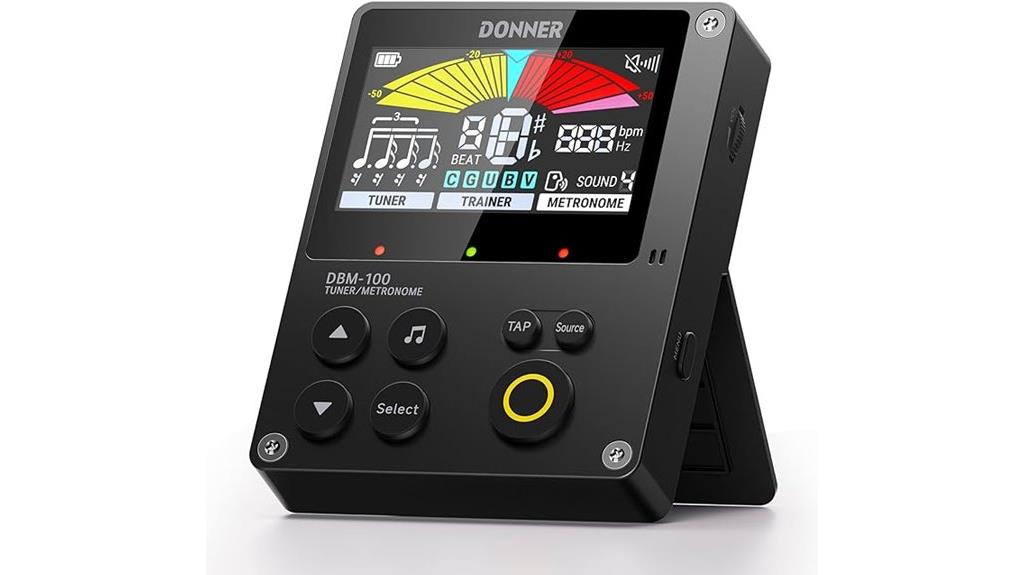
The Donner Rechargeable 3 In 1 Digital Metronome Tuner DBM-100 stands out as a versatile practice companion that’ll appeal to multi-instrumentalists who don’t want to juggle separate devices during practice sessions. You’ll get an extensive tool combining metronome functions, chromatic tuner capabilities, and tone generation within one compact unit, covering tempo ranges from 30-280 bpm with customizable beat patterns. The innovative Trainer Rhythm Mode detects your playing accuracy through light feedback, which honestly proved more useful than I initially expected for developing consistent timing. While the VA HD LCD display remains readable in various lighting conditions, you might find the initial learning curve steep due to limited manual instructions, though the rechargeable lithium battery eliminates constant replacements.
Best For: Multi-instrumentalists and musicians who want an all-in-one practice tool that combines metronome, tuner, and tone generator functions without carrying separate devices.
Pros:
- Versatile 3-in-1 functionality with wide tempo range (30-280 bpm) and multiple tuning modes for various instruments
- Innovative Trainer Rhythm Mode provides dynamic feedback through light display to improve timing accuracy
- Rechargeable lithium battery eliminates need for frequent battery replacements and features readable VA HD LCD display
Cons:
- Initial learning curve is steep due to limited manual instructions and unclear guidance
- Navigation of functions can be challenging when first using the device
- Average 3.8-star rating indicates some user satisfaction concerns despite overall functionality
Sondery Digital Metronome Rechargeable with Timer Function for All Instruments
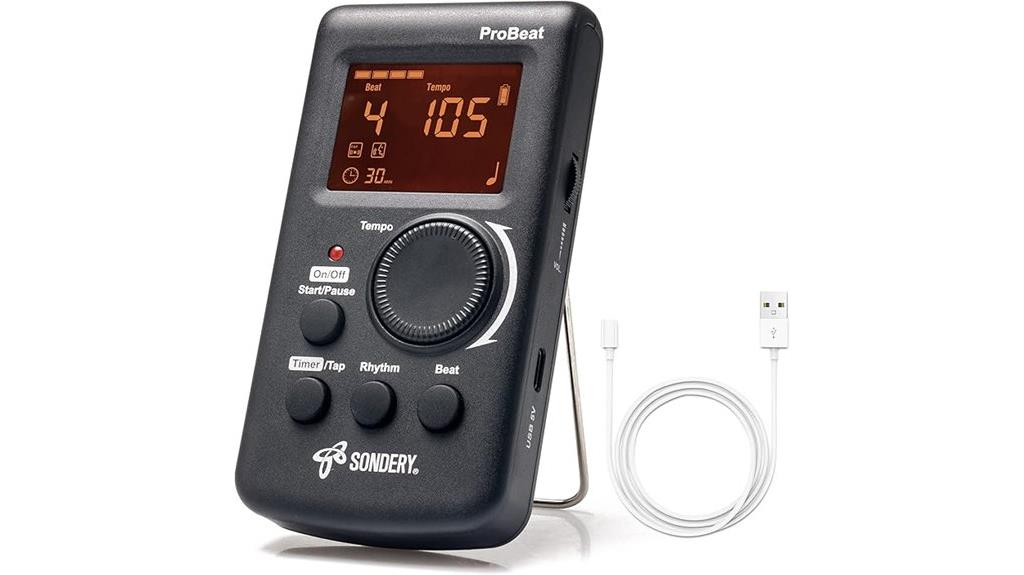
When you’re looking for a metronome that combines modern convenience with extensive practice features, the Sondery Digital Metronome stands out with its rechargeable battery system and built-in timer function that eliminates the need for constant battery replacements. You’ll appreciate its English vocal counting feature, which works alongside three digital sound options and ten beat patterns ranging from 0-9, while the rotary dial adjusts tempo from 40 to 208 bpm with precision. The compact 4.3-ounce unit includes a tap function for custom tempo input, timer settings for 15-60 minute practice sessions, and a color screen with kickstand for ideal visibility during piano practice.
Best For: Musicians of all levels who want a reliable, feature-rich metronome with vocal counting, multiple practice timer options, and rechargeable convenience for piano, guitar, drums, and other instruments.
Pros:
- Rechargeable lithium polymer battery provides up to 10 hours of continuous use, eliminating the need for frequent battery replacements
- English vocal counting feature combined with three digital sounds and 10 beat patterns (0-9) offers versatile practice options
- Compact design with color screen, kickstand, and timer function (15-60 minutes) makes it ideal for structured practice sessions
Cons:
- Volume may not be loud enough for all instruments, particularly drums or in noisy environments
- Some users experience charging issues with certain USB cables, requiring use of the included cable only
- Limited maximum volume options may not satisfy users who need louder sound output
Ueteto Mechanical Metronome Black/Loud Sound Piano Drum Violin Guitar
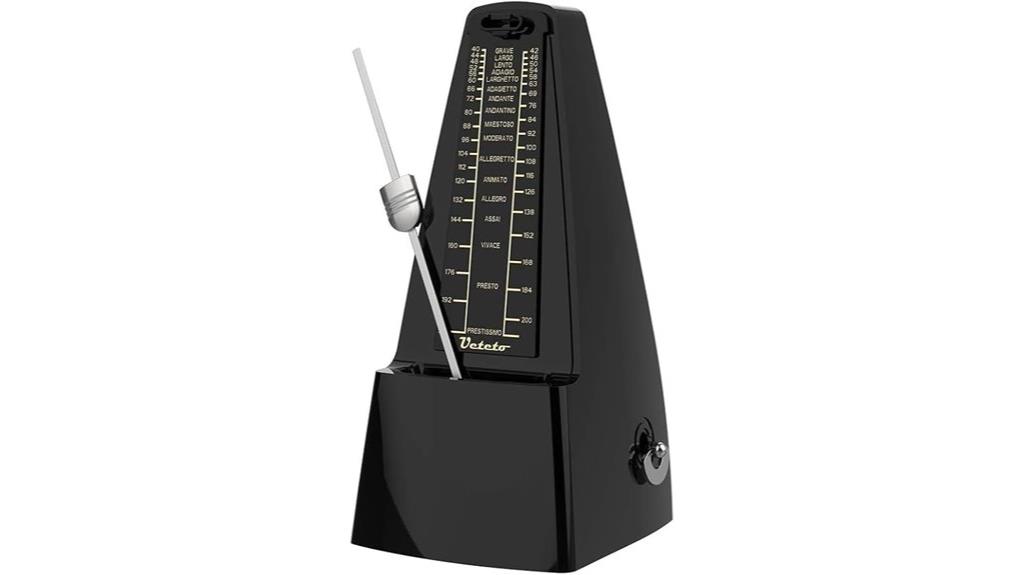
Budget-conscious musicians who need a dependable practice companion will find exceptional value in the Ueteto Mechanical Metronome, a traditional wind-up device that delivers consistent tempo guidance without requiring batteries or digital complexity. You’ll appreciate its straightforward operation, where simply removing the brake, pulling the cover, and adjusting beat and tempo settings gets you practicing immediately. The mechanical design covers 40-208 bpm with beat selections of 0, 2, 3, 4, and 6, while producing audible clicks and bell rings that cut through your piano practice sessions. Each wind provides approximately 18 minutes of continuous operation, and honestly, that’s plenty for focused practice segments without becoming monotonous.
Best For: Budget-conscious musicians and beginners who need a reliable, battery-free metronome for practicing piano, violin, guitar, bass, drums, and other instruments.
Pros:
- No batteries required with wind-up mechanism providing 18 minutes of continuous operation per wind
- Wide tempo range of 40-208 bpm with multiple beat selections (0, 2, 3, 4, 6) suitable for various musical styles
- Simple, user-friendly setup that’s ideal for children and beginners with loud, clear audible clicks and bell rings
Cons:
- Limited 18-minute operation time requires rewinding during longer practice sessions
- Mechanical design may be less precise than digital metronomes for advanced musicians
- No additional features like visual indicators, tuning capabilities, or programmable rhythms found in modern digital alternatives
Mechanical Metronome with Accent Bell (Wood Grain)
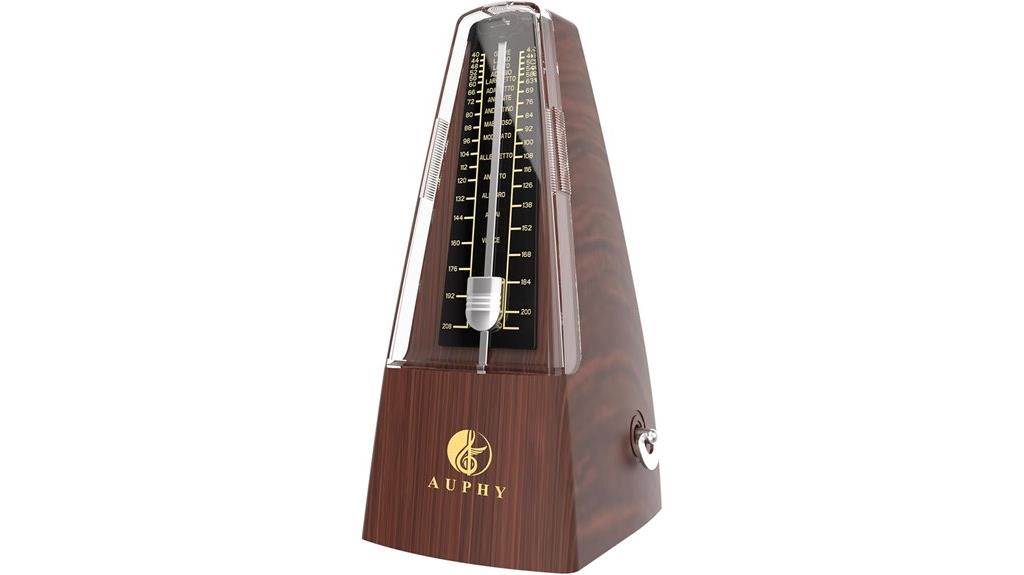
Musicians seeking traditional reliability without battery dependence will find the AUPHY Mechanical Metronome with Accent Bell delivers consistent timing through its metal clockwork mechanism, maintaining beat accuracy within just 1% variance across its 40-208 BPM range. You’ll appreciate the wood grain finish that complements your piano’s aesthetic while the lowered center of gravity prevents wobbling during intense practice sessions. The five beat selection modes (2, 3, 4, 6, and 0) give you flexibility for different time signatures, with the accent bell helping emphasize downbeats when you need that extra auditory cue. One full wind provides 10-40 minutes of consistent clicks, eliminating battery concerns.
Best For: Musicians who prefer traditional mechanical metronomes without battery dependency and need reliable tempo keeping for piano, guitar, drums, violin, or saxophone practice.
Pros:
- Exceptional accuracy with beat error controlled within 1% across 40-208 BPM range
- No battery required – one wind provides 10-40 minutes of continuous operation
- Versatile beat selection with 5 modes and accent bell option for different time signatures
Cons:
- Requires manual winding every 10-40 minutes depending on tempo setting
- At 1.19 pounds, heavier than modern digital alternatives for portability
- Mechanical ticking sound may be distracting in quiet practice environments
Digital Metronome for Piano, Guitar, Violin with LCD Display
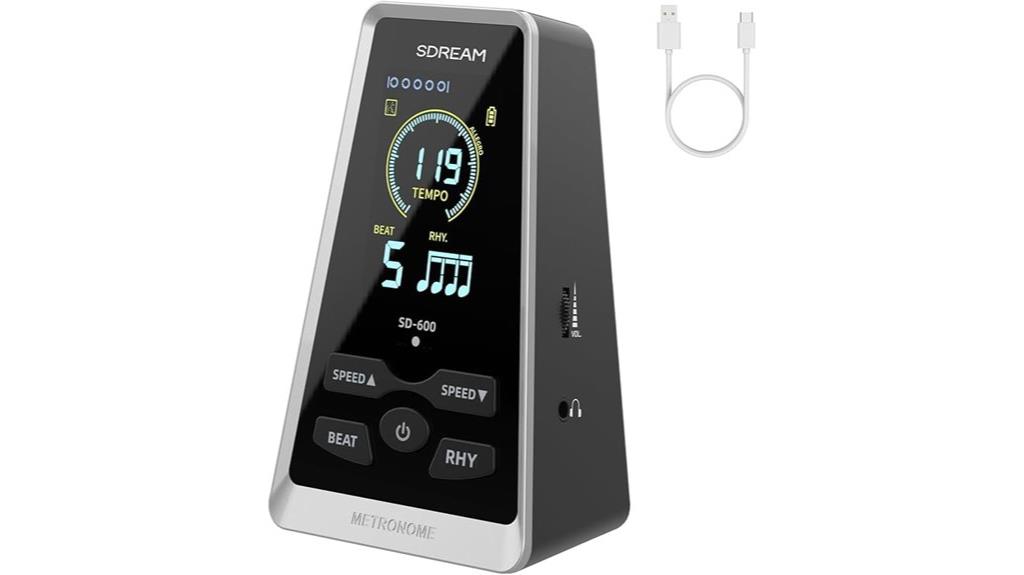
The SDREAM Digital Metronome stands out as a versatile training companion that bridges the gap between traditional mechanical precision and modern technological convenience, making it particularly valuable for multi-instrumentalists who need consistent timing across different musical disciplines. You’ll appreciate its classic pyramid design that houses modern features like dual voice options, including human English beats and electronic tones, alongside ten distinct rhythm patterns that accommodate everything from piano scales to drum fills. The adjustable tempo range spans 40 to 208 beats per minute, while the Type-C charging provides over eight hours of continuous use, and the included headphone jack lets you practice without disturbing others in your household.
Best For: Musicians of all skill levels who play multiple instruments and need a reliable, portable metronome with modern features like rechargeable battery and headphone connectivity for versatile practice sessions.
Pros:
- Versatile compatibility with all instruments and 10 different rhythm patterns to accommodate various musical styles and techniques
- Long-lasting Type-C rechargeable battery providing 8+ hours of use with convenient headphone jack for silent practice
- Compact, lightweight design (0.29lb) with durable construction makes it perfect for musicians who practice or perform on the go
Cons:
- Limited tempo range of 40-208 BPM may not accommodate extremely slow or fast musical pieces that fall outside this range
- Pyramid shape design, while classic, may be less stable on uneven surfaces compared to flat-based alternatives
- Relies on battery power which requires regular charging and may die during extended practice sessions if not monitored
Mechanical Metronome for Piano, Guitar, Violin & Drums (Black)
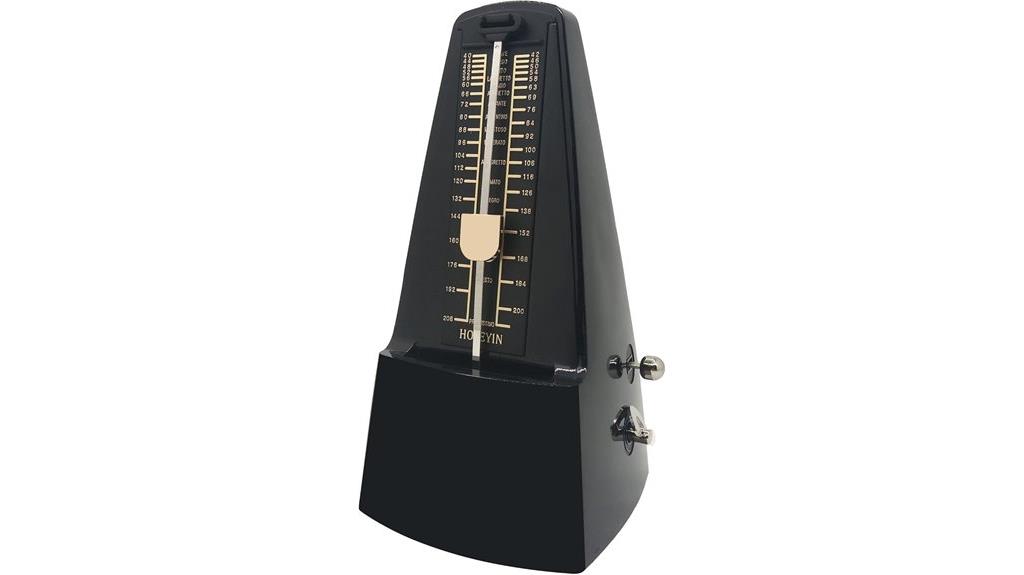
Versatility stands as the defining strength of this mechanical metronome, which serves four distinct instrument categories without requiring batteries or digital complications that often frustrate musicians mid-practice. You’ll appreciate the wind-up mechanism‘s reliability, though I’ve noticed the 40-208 BPM range covers virtually every musical scenario you’ll encounter. The variable bell options—ranging from silent to six heavy sounds—accommodate different practice environments, while the high-hardness plastic construction provides surprising stability for a 1.2-pound unit. At 4.5 stars from over 1,300 reviews, this H311 model delivers consistent rhythm training.
Best For: Musicians of all skill levels who play piano, guitar, violin, or drums and want a reliable, battery-free metronome for consistent rhythm training and practice sessions.
Pros:
- Wind-up mechanism eliminates battery dependence and provides uninterrupted practice sessions
- Wide BPM range of 40-208 covers virtually all musical tempos and genres
- Adjustable bell sound options (0-6 settings) allow customization for different practice environments
Cons:
- Bell sound can be quiet and may not be audible in noisy practice environments
- Plastic construction may raise durability concerns compared to all-metal alternatives
- Some users experienced packaging delays affecting delivery timelines
Seiko SQ50-V Quartz Metronome
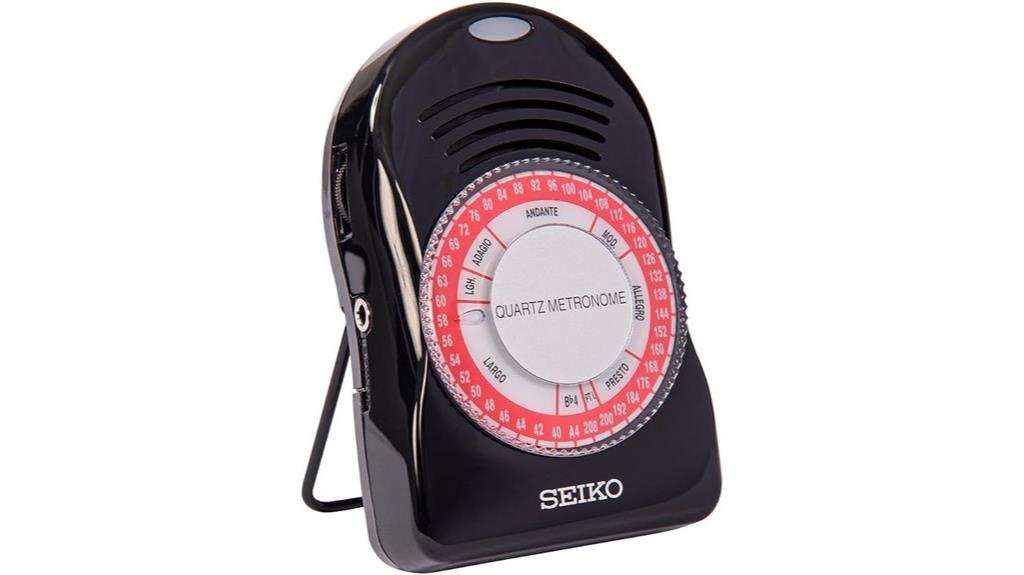
Budget-conscious pianists seeking reliable timing without digital distractions will find the Seiko SQ50-V Quartz Metronome delivers exactly what they need, nothing more and nothing less. You’ll appreciate the straightforward 39-position rotary dial covering 40-208 BPM, which lets you adjust tempo instantly without fumbling through menu screens like you’d encounter with smartphone apps. The dual-tone options—a crisp tick and warmer wood-like sound—accommodate different practice preferences, while the red LED provides visual reinforcement when you’re working in quieter environments. At 5.6 ounces with included 9V battery, it’s portable enough for lessons yet stable with its fold-out stand, earning impressive 4.5-star ratings from nearly 4,000 users.
Best For: Budget-conscious musicians who want a simple, reliable metronome without digital distractions or complex features.
Pros:
- Simple 39-position rotary dial allows instant tempo adjustments from 40-208 BPM without menu navigation
- Dual tone options (tick and wood-like sounds) plus visual LED feedback accommodate different practice preferences
- Durable construction with fold-out stand provides stability while remaining portable at 5.6 ounces
Cons:
- Battery compartment is difficult to open and close with reported connection issues
- White-on-red dial numbers are hard to read in low-light conditions
- Limited advanced features compared to digital alternatives or apps
TERENCE Digital Metronome for Piano and All Instruments
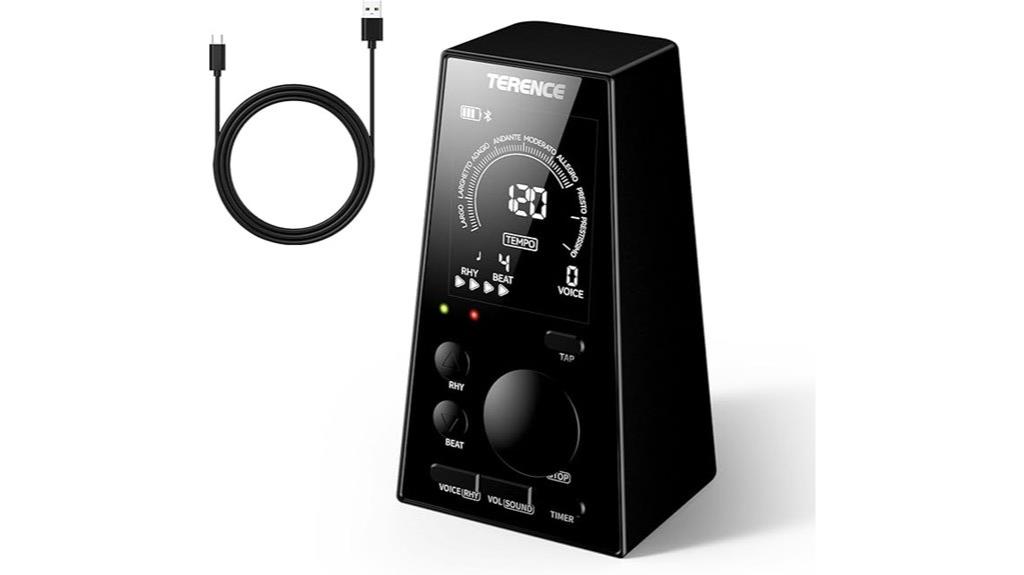
Musicians seeking millisecond-precise timing will find the TERENCE Digital Metronome delivers the advanced chip technology that traditional mechanical models simply can’t match, making it particularly valuable for pianists who demand unwavering accuracy during practice sessions. You’ll appreciate its thorough tempo range of 40-208 BPM, which covers everything from slow ballads to rapid technical passages, while the 10 rhythm patterns and 9 time signatures accommodate diverse musical styles. The large backlit LED screen guarantees clear visibility during practice, and I’ve found the easy-to-adjust dial makes tempo changes seamless mid-session. The 3.5mm headphone jack enables silent practice for those late-night sessions when you can’t disturb others.
Best For: Musicians of all levels who need precise timing for piano, guitar, drums, and other instruments, especially those who practice in shared spaces and require silent practice capabilities.
Pros:
- Advanced chip technology provides millisecond-precise timing that surpasses traditional mechanical metronomes
- Comprehensive features including 10 rhythm patterns, 9 time signatures, and wide 40-208 BPM tempo range
- Silent practice capability with headphone jack and large backlit LED display for clear visibility
Cons:
- Digital metronomes may require battery replacement or charging compared to wind-up mechanical models
- Advanced features might be overwhelming for complete beginners who only need basic tempo keeping
- Electronic components could be more susceptible to damage from drops compared to simple mechanical metronomes
Factors to Consider When Choosing a Metronome for Piano
When I’m helping pianists select their ideal metronome, I’ve found that five key factors consistently determine whether a purchase becomes a trusted practice companion or a frustrating disappointment. The tempo range capabilities, sound quality clarity, power source preferences between battery and wind-up mechanisms, visual beat indicators, and volume control options each play essential roles in matching your specific practice needs with the right device. I’ll walk you through each consideration so you can make an informed decision that enhances rather than hinders your musical development.
Tempo Range Capabilities
Versatility becomes the cornerstone of any worthwhile metronome investment, and I’ve found that tempo range capabilities often separate the truly useful devices from those destined to gather dust on piano benches. Most quality metronomes operate within 40-208 BPM, which covers everything from funeral dirges to blazing etudes that make my fingers question their life choices. I particularly value adjustable settings that let me fine-tune practice tempos, incrementally building speed without jarring jumps that derail my technique. Advanced models extend beyond standard ranges, accommodating complex compositions that demand unusual tempos. Visual aids like LED lights enhance timing awareness, while multiple beat selection modes support various rhythmic patterns, making these devices indispensable for serious practice sessions.
Sound Quality Clarity
Clarity transforms a metronome from a basic timekeeping device into a precision practice partner, and I’ve discovered that sound quality can make or break countless hours spent at the keyboard. I need adjustable volume controls that accommodate my practice environment, whether I’m playing softly during late-night sessions or working through forte passages. The sound type matters tremendously—I prefer warm, wood-like tones over harsh digital beeps because they blend naturally with piano acoustics without creating jarring contrasts. Clear accent capabilities prove essential when I’m working in different time signatures, as distinct downbeats help reinforce complex rhythmic patterns. Higher-quality models deliver crisp, recognizable sounds that maintain my focus without becoming distracting during extended practice sessions.
Battery Vs Wind-Up
Two fundamental power sources define the metronome landscape, and I’ve found that choosing between battery-powered digital models and traditional wind-up mechanisms involves weighing convenience against reliability in ways that directly impact my practice routine. Battery-operated units offer digital displays, adjustable electronic sounds, and additional features like tuners, though they require regular battery replacements that can interrupt sessions at inconvenient moments. Wind-up metronomes eliminate power dependency entirely, providing 18-40 minutes of consistent operation per winding with that distinctive, resonant mechanical sound many pianists prefer for its acoustic qualities. While I appreciate the versatility of digital models, there’s something invigoratingly straightforward about wind-up mechanisms that never fail due to dead batteries, making them surprisingly reliable companions for extended practice sessions.
Visual Beat Indicators
Why wouldn’t a pianist want to see their metronome’s beat patterns when visual reinforcement can dramatically improve timing accuracy during complex passages? I’ve discovered that LED lights and display screens provide essential visual cues that complement auditory clicks, especially when practicing difficult repertoire where maintaining focus becomes challenging. Color-coded lights that change with each beat offer particularly effective synchronization tools, allowing me to stay locked onto the tempo even in acoustically problematic practice rooms. Moving pendulums and rotating dials create tangible tempo representations that help develop internal timing awareness, which I find invaluable for beginning students who struggle with purely auditory guidance. Many digital models now feature customizable visual settings, enabling personalization based on lighting conditions, personal preferences, and specific practice environments.
Volume Control Options
Three distinct volume scenarios demand different metronome capabilities, and I’ve learned that the right sound control features can make or break your practice sessions. When I’m practicing late at night in my apartment, I need precise volume adjustments to avoid disturbing neighbors while maintaining audible timing cues. Digital models with headphone jacks solve this problem entirely, delivering direct audio feedback without external sound. During daytime sessions, I prefer metronomes offering multiple tone options—high-pitched clicks cut through piano sounds better than low tones, though personal preference varies greatly. Fine-tuned volume control becomes essential in noisy environments where standard click levels get lost among competing sounds, and I’ve found that models allowing incremental adjustments rather than basic high-low settings provide superior practice flexibility.
Portability and Size
When I’m hauling my metronome between piano lessons, recitals, and practice rooms, I’ve discovered that size matters more than I initially expected—compact digital models weighing around 4.3 ounces slip effortlessly into my music bag’s side pocket, while traditional mechanical units tipping the scales at over a pound demand dedicated space and careful handling. I’ve learned that portability isn’t just about weight; those convenient foldable stands and kickstands make setup quick whether I’m practicing outdoors or cramped in a tiny rehearsal room. The rechargeable batteries in portable digitals eliminate my constant battery-buying habit, though I’ll admit those hefty mechanical models offer superior stability when my piano bench vibrations threaten lighter units during intense practice sessions.
On a final note
I’ve tested countless metronomes throughout my piano journey, and honestly, finding the right one makes practicing infinitely more effective. Whether you choose a traditional mechanical model with its satisfying tick or opt for a feature-packed digital version with tuning capabilities, consistency matters most. Don’t overthink it—pick one that matches your budget, practice style, and volume needs, then actually use it regularly.

